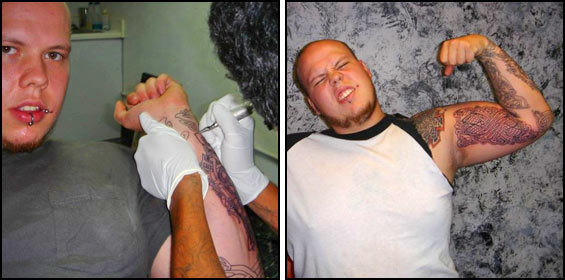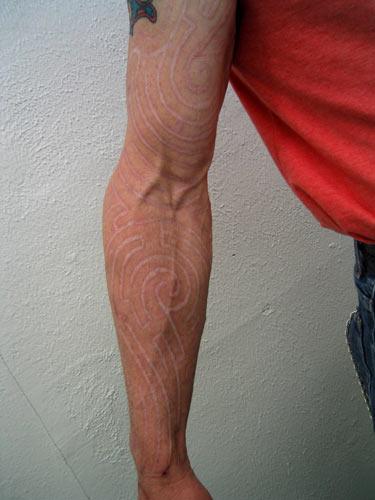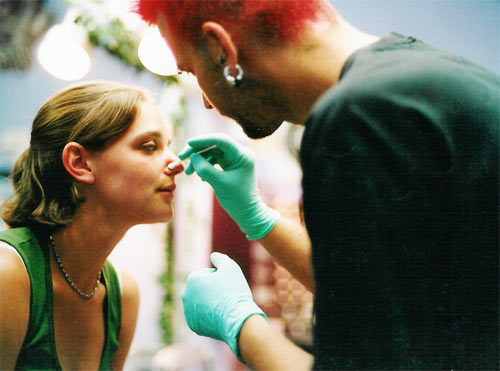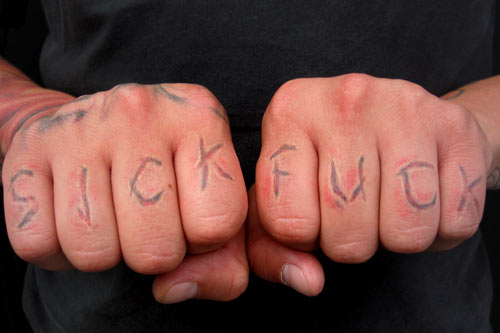
Troy Amundson is the perfect piercer poster person. A body modification artist for over seven years, he’s spent the last three lobbying for safe piercing in his state of Washington and also working to ensure that certain practices, such as those beloved on BME, are not banned. He’s been written about in the mainstream press numerous times as an unlikely lobbyist — unlikely in looks perhaps, but his effectiveness is undeniable. He’s kept body piercing bills on the front burner when some legislators claimed it was not a high-priority issue. Yet, the piercing bill is not the only thing on Troy’s plate. He’s working on the revision of the Seattle Municipal Code on Tattooing, and for a task like this, you want someone who knows and loves the art. He’s co-authored articles for medical journals on piercing practices, educating nurses and doctors as well as changing many of their attitudes towards those in our community. And he’s also one of those behind the MedPierce Kit, a body jewelry removal kit for healthcare facilities and correctional facilities. Troy’s a busy man. I spoke with Troy because his experiences inspire action. Moreover, he can teach us all techniques on how to fight for safe and fair body modification legislation and make a difference. MDM: First, I want to start by thanking you for your lobbying efforts to keep piercing safe in Washington state but also fighting to keep body art practices free from what I call “morality” legislation — laws passed not to protect the public but because legislators negatively view the outlawed practice, such as the proposed body art ban on Long Island, NYC that seeks to outlaw genital piercings and facial tattooing, among others. Have you always been politically active? TA: Thank you, I really appreciate the support. Encouraging words have definitely motivated me to keep going. I have rarely voted and have never attended a political rally. I was skeptical of the value of one citizen. I was disillusioned with what I saw as a corrupt and broken system. I never believed that one person could really make a difference. Take for example, our last presidential election. Regardless of partisanship, how many people were frustrated with the overall outcome? Counts, recounts, and court decisions. Followed by allegations of miscounts, fraud, and voter intimidation. Similar events recently affected Washington’s gubernatorial election. The power to reform the government is within our hands, not theirs.
Troy Amundson on Capitol Hill with his son MDM: Then I guess your view of government has changed. TA: 179°. I still have grave concerns over many issues that face society today. The major difference is that I have witnessed the power of a citizen’s voice. For many reasons, I believed I was an unlikely candidate to lobby. When I initially agreed to help with the project, I thought the lobbyists would want to keep me as far away from legislators as possible. Instead, the lobbyists decided to put me in front of as many legislators as possible. Under their guidance I learned how to play the game. I was under constant supervision the first year to avoid mistakes. All of my statements to legislators and the media were drafted and closely scrutinized. Now they find it amusing to watch me run rampant. MDM: Let’s go back. What prompted you to take action? TA: Opportunity and concern. A local public health official notified me that a concerned parent with connections and experience working in the capitol wanted to try to pass regulations for body piercing. Immediately, I recognized the implications that may have had on my beloved profession. There is nothing more fearsome than a mother protecting her young. Thankfully, due to an ongoing working relationship, the health official referred the woman to me.
Troy proposing to his financee from PURE Cirkus after the Pleasure 7 Pain show MDM: So what did you do? Can you describe your lobbying efforts and the political process? TA: I was fortunate enough to have the guidance of two professional lobbyists, one Democrat and one Republican. The Republican, Vito, is 81 and has become a fixture after dedicating over 40 years to working various jobs in the capitol. Vito has helped many people start careers in politics (including Democrats). His advice is widely respected and often sought by both parties. Regulations for body art procedures are a good public health issue due to the social popularity of these arts. It is also rare for any industry to step forward and request restrictive regulations. The issue has advanced meritoriously and by our pro-active position. The legislative session moves very fast. Legislators must brief themselves on hundreds of bills introduced in a session. They rely largely upon established relationships with others to determine their position on particular issues. For example, if I were a legislator, I would probably find public health issues the most interesting. While I may passionately research dozens of public health issues pending that session, there simply is not enough time to evaluate all the bills. Some issues, like the budget, would be extremely difficult for me to find any interest in. Unfortunately, my vote would ultimately be decided by facts provided by other legislators, capitol staff, lobbyists, and hopefully my constituents. As a lobbyist, or citizen lobbyist, you must spend time developing relationships with the legislators. In our case, we have developed very strong relationships with numerous legislators. For example, this year, legislators were faced with six bills to regulate body art. Through that earned trust, many legislators simply turned to my evaluation of the bills. We have maintained two goals in this effort:
A large part of our strategy relies on professional conduct, ethical lobbying, and a nonpartisan delivery of fact-based information. It is difficult to set aside personal feelings at times. There is no room for ego and nothing gets accomplished through partisan rhetoric.
Full sleeve branding by Troy Amundson MDM: What was it like testifying on behalf of piercing professionals before the state legislature? TA: This year I testified before various committees six times. I get nervous every time. I know that my words could sway opinion for, or against, our issue. No committee member likes it when a testimony drags on. Keep it short, make your points, and don’t waste time. Script everything and print it in an easy to read format. For body art issues, you probably have two to eight minutes to testify. Do not let too many people testify, perhaps two or three. If questioned, answer directly without too much extra information. The amount of time you are given will largely rely on the Chair or Vice Chair. I witnessed a notable difference in the treatment given to me opposed to the treatment of those supporting the morality bill. In committees where I had favor, I was allowed time to make my points. Most committee members listened intently to what I had to say. Our opposition was frequently challenged, interrupted, or simply cut short. If a bill is lobbied correctly, most of your work is done before the committee hearing. MDM: What kind of effect do you think your testimony had on the state legislature? TA: The demonstration of our willingness to work with legislators on body art related issues has been commended and continues to draw bipartisan support. We may not have passed a bill yet, but we have changed many opinions about the industry and body art in general. In one hearing, a doctor from Public Health Seattle & King County testified in support of one of our bills. I gave a brief testimony in support. The only question from the committee was directed to me. A “morality bill” that targets the industry, and not the protection of public health, has repeatedly threatened artists. Last year the bill passed the Senate. This year the bill died in committee, not even advancing to the Senate floor. This can only be credited to the continued education of the legislators on body art issues. Immediately after my testimony against the bill, five out of eight of the Labor & Commerce committee members signed as sponsors on our bill. Interestingly, the Chair of the committee sponsored the bad bill last year and our bill this year. After one of my testimonies, the sponsor of the “morality bill” screamed at me and accused me of lying to the committee. He has portrayed us as opposing his bill because we are trying to avoid oversight. He has repeatedly stated that without licensing, enforcement, and inspections, our bill only provides an “illusion” of regulations intentionally providing the public a false sense of security. It would be easy to cast me as opposed to licensing and inspection. It is becoming far more difficult for the supporters of the “morality bill” to make a logical argument. Where most legislators had no understanding of body art before, they are starting to recognize what is fact and what is not. Our persistence and pro-active approach does not reflect an industry trying to avoid oversight. Reviewing my testimonies and statements in the media, you would see that I support licensing and inspection. Legislators recognize that we are trying to take a positive step forward. With two exceptions, one minor and one major, I have received very professional treatment. Many of the legislators and lobbyists freely shared strategic advice with me. This year I was treated in the exact same manner as a professional lobbyist. Several of the lobbyists even claimed me as one of their own. Not one campaign donation has been made. I doubt any member of the Washington State Legislature will ever look at body art in the same way again. MDM: That’s fantastic! So what’s the status of the Bill? TA: Our bill is dead this year, but this is also the farthest that our issue has progressed. The Chair of the Labor & Commerce committee has stated the committee will be reviewing this issue during the interim. Thanks to invaluable established relationships, I foresee closed-door meetings in my near future. I am taking at least a year off. I will not be proactively lobbying for regulations next session, but I must make myself available to advise legislators on body art issues. MDM: In these efforts did you get a lot of help and support from the tattoo and piercing community? TA: Many artists have been extremely supportive, although many people do not know what they can do to help. Tattoo and piercing related issues can, and should, be widely supported by our clients as well. While public testimony should primarily be delivered by artists, there is no reason not to pack a hearing room with tattooed and pierced citizens. It is really hard for any committee member to ignore, especially when we tend to stick out from everyone else. High-visibility has become a significant advantage in our fight. Our issue would have benefited from more support. Emailing legislators and attending committee hearings become essential methods of support. Unfortunately the legislative session moves very fast. Even with close ties, I usually only had three to seven days notice between the time our bill was placed on an agenda and the time it was actually heard in committee. Many artists did not attend because of scheduling conflicts. No, it is not convenient. My commute to the capitol is about 65 miles (ranging from an hour to two and a half hours each way, one to four times per week) when working a bill. In addition to taking time off, I have incurred hundreds of dollars in gas expenses alone. Yet, it is extremely important to make time, especially when opposing legislation. I am sure most clients would understand and be supportive if the situation was explained. I strongly encourage shop owners to close for the day and make the event a shop outing. Encourage your clients to attend or offer to take them with you. It is disappointing to see artists take a day off after a night out drinking, but not when it really matters. The costs incurred individually far outweigh the costs of bad regulations. Clients can encourage their artist to get involved.
Troy piercing at Apocalypse Tattoo MDM: Beyond the Bill, you’ve also worked on the revision of the Seattle Municipal Code on Tattooing. How did you get involve in that and what changes did you advocate? TA: I have only recently begun working on a revision of the Seattle Municipal Code. I got involved the same way I became involved with the legislation, through having an established relationship with my local health department. I was invited to participate by both the City of Seattle and Public Health Seattle & King County. I have difficulty refusing such invitations. Many artists in the state have put aside personal and professional differences to support this cause. We will prepare a draft of the proposed new code, and then circulate it through shops for input. The process will take some time. The City of Seattle and Public Health Seattle & King County are very determined to hear input from the industry and develop a strong working relationship. One of the reasons for taking time off from lobbying is to focus more on the revision. MDM: And on top of all this you’ve also been active in educating the medical community on body piercing. Tell me about that. Has the medical community been receptive to what you have to teach them? TA: Body piercing motivated me to pursue training as an emergency medical technician. I teamed up with Scott DeBoer, a flight nurse from the University of Chicago Aeromedical Network. Scott’s specialities include flight, ER, and pediatric care. Scott had noted in his research that medical articles varied widely on body art issues and rarely included any perspective from artists. Scott lectures internationally, and objectively reviews health issues and medical concerns associated with body art. And bless his little Ned Flanders heart, he has become an advocate for body art. Ned now knows more about body art than many of his colleagues who have body art. I would also have to thank Elayne Angel and David Vidra. Often when I feel a question is out of my league, I have turned to their input. Many others have helped as well. Much of our research has been published.
Our research led to the subsequent design and production of a jewelry removal kit www.medpierce.com for licensed healthcare providers and correctional facilities. The kit was released in October 2006. While sales have initially been slow, the reviews have been very promising. MDM: This kit sounds like a great idea and much needed in the medical community. Through all this research and experience, you have a wealth of information to share with the piercing and tattoo community. What advice do you have on promoting safe body modification practices and also ensuring that certain practices are not banned? How can we best make our voices heard? TA: Learn the art of compromise and sometimes we must tone it down. Before anyone gets reactionary, let me clarify. Let’s take scarification for example. The very concept itself, artistic scars, is extreme for a large portion of the public. Originally, the lobbyists were extremely concerned how legislators would respond to words like brand, cut, or scalpel. Our priority became protecting the right of clients to have scarification and a right for the commercial application of scars as body art. One question that we did not try to address was what instruments were allowed to produce a scar. We simply stated that scarification should be regulated in a similar fashion to piercing. The procedures warrant the necessity of sterilization and hygiene requirements. Some states legally allow the use of scalpels, and other states do not. While I love scarification as an art, there is a justifiable concern over the use of certain implements. What is more important, our right to have beautiful scars, or the tools used to make them? Start small. Get involved. Start discussing issues with other artists/shops in your area. Put aside differences to support a greater cause. As frustrating as it may be at times, you always have to play it cool and professional. It is “us” against “them”. The only way to win is to have more of “us”. And not just artists, that includes everyone — legislators, public health officials, clients, the public, and the media. MDM: What’s next for you? Politics maybe? TA: I just want to pierce and burn people. Then nursing school. While legislators, clients, and friends have commented on the future of a political career, there may be too many skeletons in that closet. But one could argue that far worse criminals have been elected.
Copyright © 2007 Marisa Kakoulas. This online presentation copyright © 2007 BMEzine.com LLC. Requests to republish must be confirmed in writing. For bibliographical purposes this article was first published online April 18th, 2007 by BMEzine.com LLC in Toronto, Canada.
|
Tag Archives: legal-link
Oklahoma Lifts Body Art Ban! [Legal Link]

By Marisa Kakoulas DiMattia Oklahoma — the last US state to outlaw tattooing — will now lift its body art ban and a law legalizing and regulating tattooing will take effect November 1st of this year. No longer will Oklahomans be relegated to their cousin’s kitchen table to get needled. No longer will police raid tattooists while the state makes the Top 15 in the nation for violent crime. And no longer will it be illegal to pay homage to Garth Brooks, Oklahoma’s homeboy, with a portrait tattoo tribute.  Tattoo of another musical icon, done “illegally” in Oklahoma Today, the Governor of Oklahoma signed Senate Bill 806, which recently was passed in the Oklahoma House of Representatives and Senate. House Representative Al Lindley, who co-authored the bill with State Senator Frank Shurden, has tried for the past seven years to pass legislation to legalize tattooing. This year he succeeds. Previous attempts to pass this legislation were been blocked by Republican legislators in Oklahoma on “moral grounds.” But perhaps this year they realized that having their constituents get tattooed in unregulated and unsanitary conditions, risking infection, is not only immoral, it is unjust. Then there’s the case challenging the ban filed by a tattooer arrested in a studio raid. A court ruling that the ban is illegal means that tattooing in the state may have been legalized with legislators having no say at all. This seems to have lit a fire under their pious butts. Still, morality will figure prominently even if Bill 806 is passed. House amendments to the tattoo bill include a prohibition on body art business operating within 1,000 feet of a church, school or playground. In a state where there’s a church on every corner, this is no small restriction [Editor’s note: Jon from Fishing Fury points out that this is potentially a racist law due to the increase in church volume in African American communities in Oklahoma]. Evidently, legislators felt the need to protect Oklahoma’s youth from, say, tattooed lawyers like myself.  Even looking at this tattoo, done “illegally” in Oklahoma, can turn you to stone or worse! Another obstacle for tattoo and piercing business owners is the requirement to post a surety bond of $100,000 in order to be licensed — an incredibly high amount. While tattoos may have become mainstream, most artists I know are not endowed with trust funds [Editor’s note: So the law is class-ist as well?]. Those operating without a license once the bill is passed will face stiffer penalties as well; instead of the current $500 fine, a penalty of $5,000 will be imposed. The possibility of up to 90 days in jail remains the same. Despite the restrictions and high fines, the tattoo bill does do a lot of good by protecting tattoo lovers from the risk of infection and hepatitis. (An outbreak of hepatitis B in one Oklahoma county was tied directly to unsanitary home tattooing practices.) In order to be licensed, and therefore legal, tattooers will be required to obtain training in blood-borne pathogens, their work environment must conform to health and hygiene standards, equipment must be inspected, and procedures such as single-use needles and ink caps must be adhered to, among others. The new law will also prohibit artists from tattooing anyone under 18 or under the influence of drugs or alcohol.  Oh, but breaking the law was fun! Properly trained tattooists already follow these standards so they shouldn’t be overly burdensome. The law will be heavy for kitchen table scratchers. While you can get a home tattoo kit off of eBay for cheap, autoclaves and other sterilization equipment are expensive. Tattoo artists that follow the rules have higher costs and, thus, their prices may be higher. With tattooing legalized, these artists will face less competition from bargain-rate amateurs who may charge less but at the cost of the client’s health.  At the First Oklahoma Convention There’ll still be plenty of Oklahoma artists to choose from anyway. According to The OU Daily, 300 underground artists are already tattooing in the state with 14 tattoo studios openly doing business in the Oklahoma City area despite the ban. A tattoo convention in Tulsa even took place April 1 & 2nd, drawing local and national artists to The Hive club, the only place willing to have the event. Interestingly, the police didn’t conduct one of their tattoo raids at the convention. The Tulsa County District Attorney Tim Harris told the Associated Press that tattoo law violations are a “low priority” compared with the load of homicide cases he faces. Now police can catch real criminals instead of arresting artists. Marisa Kakoulas DiMattia This article was not intended as legal advice. It is intended for only general information purposes. This article does not create any attorney-client relationship.
|
Waivers and Releases for Tattoo and Piercing Studios [Legal Link]
Above are sample release forms for tattoo and piercing studios. If you use them, get them reviewed by local counsel first. You may want to edit them to include more (or less — but CYA) risks and medical conditions, or make other changes to suit your studio’s needs.
Waivers can protect studios from suit for all different kinds of potential harm, such as infections, scarring and keloiding, allergic reactions to ink or green soap, a kanji placed upside down and, my favorite, misspelled tattoos The simple fact of having signed a waiver and release can discourage many clients from seeking to sue you in the event of a problem. Similarly, a client who goes as far as to talk to a lawyer will find that most lawyers will turn them down as a client if there exists a well-written waiver and release — unless the circumstances are particularly nasty, the lawyer won’t view the case as worth their time and effort. And in the event you do end up in court (or even small claims court), the client’s executed waiver and release will be a strong defense.
GOOD PRACTICE TIP: In the case of spelling a tattoo, it is always a good idea to have the client print out themselves the names or words to be spelled — a good location for this is the back of the waiver or release and have the client initial the spelling.
For clients of piercing and tattoo shops, this means you must be well educated in the risks of the trade and accept those risks before signing your rights away. You always have the option of going to another studio with no waiver to sign or to one that is less restrictive on limiting liability. Or simply don’t get the mod.
KNOW YOUR LOCAL LAW
Laws differ from state to state, city to
city, county to county. Thus, writing any kind of overview of US law is like
hitting that fifth hour of a non-stop tattooing session — it’s outright painful.
(I speak from experience on both counts.) But unlike getting a backpiece, where
the only thing to do is just deal with the pain, here I can lessen the legal
load by providing my own CYA clause:
Get a local lawyer to draft or at least review the free sample waivers provided in this article (Perhaps get other shops nearby to share this cost with you). Do not rely solely on this article as legal advice. A waiver and release that does not take into account the specific laws applicable to where your shop is located may not be any protection for you at all. Instead, feel free to think of this as just learning something new to sound smarter at dinner parties.
With that off my shoulders, let’s
get under the skin of tattoo waivers and releases.
Most US states will enforce a waiver or release, although some hold them to a more rigorous standard than others. And at least three states — Louisiana, Montana, and Virginia — have deemed waivers against public policy unenforceable, according to “Liability Waivers” an article on waivers for the health and fitness industry by Dr. Doyice Cotten, co-author of Waivers & Releases for the Health & Fitness Club Industry. The eight states that are most lenient in upholding waivers are Idaho, North Dakota, Michigan, Alabama, Georgia, Tennessee, South Carolina, and Maryland. While Cotten based his research on sports-related waiver cases, the findings could be analogized and extended to tattoo and piercing waivers.
Other states have their own peculiarities. In California, for example, an express waiver of the provisions of Section 1542 of the Civil Code may be necessary to obtain a waiver and release that is effective against future claims. It is standard practice in California for a waiver and release to contain a provision such as the following:
(If you are a resident of the State of California) I agree to waive the provisions of Section 1542 of the Civil Code of the State of California, which provides as follows:
A GENERAL RELEASE DOES NOT EXTEND TO CLAIMS WHICH THE CREDITOR DOES NOT KNOW OR SUSPECT TO EXIST IN HIS FAVOR AT THE TIME OF EXECUTING THE RELEASE, WHICH IF KNOWN BY HIM MUST HAVE MATERIALLY AFFECTED HIS SETTLEMENT WITH THE DEBTOR.
I understand that section 1542 gives
me the right not to release existing claims of which I am not now aware,
unless I voluntarily chose to waive this right. Having been so apprised, I
nevertheless hereby voluntarily elect to, and do waive the rights described in
section 1542, and elect to assume all risks for claims that now exist in my
favor, known or unknown, from the subject of this Waiver and Release. I
acknowledge that I have had the opportunity to consult with legal counsel of
my own choosing and to have the terms of this Waiver and Release fully
explained to me; that I am not executing this Waiver and Release in reliance
on any promises, representations or inducements other than those contained
herein; and that I am executing this Waiver and Release voluntarily, free of
any duress or coercion.
GOOD PRACTICE TIP: Know the laws that apply to you. Many states, cities, counties and local munincipalities now regulate tattooing and piercing in some way. You should get a copy of these statutes for your reference and keep them in your shop as well as provide them to any artist working in your shop. And don’t rely on these laws as to not change. Tattooing and piercing, as it has become more mainstream, has attracted greater attention-and motivated some people to seek greater regulations and restrictions on it from restricting who, what and where a person may be tattooed to zoning laws on where you shop may be located. It’s your responsibility to stay up on changing laws that may affect you. It’s much easier and effective to counter an attempt at increased regulation of your profession before such laws are enacted [But that’s for another article.]
NO DRUNKS AND MINORS
Whether your state court will enforce the waiver or release is going to depend on who is signing it. “Capacity” of the person getting the tattoo or piercing is key, according to attorney Ronald D. Coleman of the Coleman Law Firm and general counsel of the Media Bloggers Association. He says:
“At least as important as any issue having to do with the text of the release form is that the tattoo shop owner must be confident that the person getting that tattoo is not impaired and is an adult. [This is “capacity.”] It is not enough for the release form merely to recite the fact that the person signing it contends he is not impaired; if the tattoo shop owner’s own non-expert observation suggests an impairment, this term of the contract likely will ‘not be worth the paper it’s printed on.’ As a general rule, the law will uphold substance, not form.”
What this means is, if a person staggers into your shop drunk, reeking of whiskey, and asks for a Britney Spears portrait tattoo on his chest — even if he’s willing to sign away all liability — he just may come back and sue you when he sobers up and possibly win. “Oops, I did it again” is not a valid legal defense.
Less obvious, a client who speaks fractured English may not be bound by a waiver or release that is written in English. So, if you have a clientele that speaks Spanish, for example, it would be a good idea to have on hand a form of release that is written in Spanish.
It also means that an attractive young woman who could easily pass for 18 years of age and wants to pierce her navel must still provide ID showing she’s the age of consent for this type of piercing in your state. The R. Kelly “she looked 18” excuse just wont cut it unless there’s proof or a parent around.
GOOD PRACTICE TIP: Photocopy the ID’s supplied by the client and parent (if applicable) and attach to the copy of the waiver and release you keep on file. Educate yourself to be able to spot a fake ID or driver’s license as well — and if you are in doubt as to its validity, turn the client away!
Which raises the question: Can parents, signing a tattoo or piercing release form on behalf of their child, thereby, sign away their child’s rights to any damages arising from the procedure?
The answer is yes and no. Again, it all depends on the state, city and county in which your shop is located.
Looking at cases where parents have signed releases for horse riding or ski lessons, cheerleading practices, and a variety of sporting and extracurricular activities, the courts are divided across the US on whether to enforce waivers signed on behalf of minors. For example, a Washington court refused to uphold a ski school’s release even after the mother of a child who was injured during ski lessons signed the agreement releasing the school from any liability for negligence. That court held that parents generally do not have the right to waive their child’s own future action for present injuries sustained from a third party’s negligence. Yet, in a similar case in Colorado, that state’s high court upheld a waiver signed by a parent of an child injured while skiing and found for the defense.
This Colorado case and many other cases that have upheld waivers and releases signed by parents for their minor children cite the 2000 Supreme Court decision of Troxel v. Granville for the principle that “the interest of parents in the care, custody, and control of their children is perhaps the oldest of the fundamental liberty interests recognized by [the US Supreme] Court.”
Therefore, having a child’s belly button pierced is a right that many parents have — as noted, for example, in Connecticut, under General Statutes sec. 19a-92g, explicitly permitting a parent to consent to body piercing of an unemancipated minor child. Just keep in mind that not all state legislatures are as evolved as Connecticut’s.
GOOD PRACTICE TIP: As a general rule, it is probably not a good idea to tattoo a minor — even with a parent’s consent, unless you know the parties very, very well. Whereas a piercing is “temporary”, a tattoo is more permanent and difficult to remove if the wearer or parent later regrets the decision. So, why risk it?
GET THE LANGUAGE RIGHT
Even those state courts that uphold releases
are still going to check to see if the waiver or release is properly drafted.
[While I attempted to make the sample agreements as detailed as possible, they
cannot be considered properly drafted until signed off by an attorney
knowledgeable of your local law.]
The problem with many releases is that they are overly broad. Tons of Internet sites offer free legal forms, but I have yet to find one that fully covers the specifics of tattoo and piercing studios.
I did find one that made me laugh on Overlawyered.com that was created by tattooist Pat Fish. In Pat’s release, she also includes the line “I am not a lawyer, nor do I work for one.” For those lawyers that want ink from Pat, she makes them circle the provision and next to it write “But I am ashamed.”
Clauses for professional self-loathing aside, waivers should be specific as to what is involved and what can go wrong. If you own a studio that provides both tattoo and piercing services, have a separate release for each, and have each list their specific risks. For example, the samples provided in the article include risks such as scarring and infection. You could modify the samples so as not to scare away your clients, but like I said, it’s all about CYA.
Another CYA clause, is one that requires the client to properly care for the tattoo or piercing while it’s healing. But Robert Coleman points out that this provision is “fairly worthless if [the client] has not been properly instructed in that care.” He adds, “It is a good idea to give the customer written instructions on care and for him to sign a separate receipt proving that he received them.”
GOOD PRACTICE TIP: Aftercare instructions should be clearly posted on the wall in the studio in a visible and conspicuous place. Each client should receive a printed copy of aftercare instructions BEFORE commencing the tattoo. Upon completion of the tattoo or piercing, the artist should review the aftercare instructions with the client and ask if there are any questions. Keep a pile of aftercare instructions available in the studio’s lobby/waiting area for clients to take with them.
Coleman also favors considering an attorneys’ fees provision in waivers, requiring the loser of any litigation to pay the other side’s attorneys’ fees and costs. “This will certainly discourage meritless litigation. On the other hand, the risks here are fairly obvious.”
An artfully drafted release or waiver with a host of specific provisions on tattooing or piercing is a great line of defense against potential law suits, but the courts will also look to make sure that the client actually read the agreement and understood what they were signing. In my sample waivers, there are lines next to each provision for the client to initial. They are also drafted in clear language, and in readable font, so that you don’t need a law degree or a magnifying glass to read them.
GOOD PRACTICE TIP: Reproduce your waiver and consent form in easily readable type and preferably on a single sheet of paper (printing it on the front and back if necessary) so that the signature is never separated from the waiver itself.
NEGLIGENCE OR GROSS NEGLIGENCE
You’ll also find a provision in my sample
specifically releasing the studio from liability for their own negligence. Some
states, including New York and Delaware, among others, require such language
waiving claims arising from “fault” or “neglect.” Other states don’t require it,
but it may not hurt to have it.
Negligence is failure to exercise due care — care that a reasonable, prudent person would exercise under the same circumstances. On the other hand, gross negligence is the failure to use even the slightest amount of care in a way that shows recklessness or willful disregard for the safety of others. While in some cases ordinary negligence can be waived, gross negligence or intentional misconduct cannot. So what does that mean for tattoo and piercing shops? Where is the line drawn between negligence and gross negligence? No US cases were found where the courts look at this line in the context of tattoo and piercing shops, but we can make a guess for the following scenarios:
- Answering the phone and not changing your gloves before touching the client again?
Could be ordinary negligence - Dropping your needles on a dirty floor and then using them on a client?
Sounds like gross negligence. - Tattooing or piercing too deep so as to cause scarring?
Maybe ordinary negligence.
- Tattooing or piercing while drunk or high no matter the outcome?
Probably gross negligence.
Whether a court agrees with these guesses is the real issue — it depends upon an examination of the facts in each circumstance, and a court’s ruling may vary from state to state, county to county. The important point to keep in mind, however, is that no waiver or release can protect you from claims of gross negligence.
GOOD PRACTICE TIP: Do not assume use of a form of waiver or release to absolutely protect you from any claims. It is your responsibility in your shop to institute procedures for all artists and employees to follow to assure that the laws you are subject to are complied with and that procedures to assure the sterility and safety of the application of all tattoos and to prevent the cross-contamination of instruments, surfaces and materials (pigments) is scrupulously followed.
WAIVERS DO NOT COVER ILLEGAL ACTIVITY
According to the basic principles of contract
law, you cannot enforce a contract for illegal activity. Then again, the client
who also engages in the illegality may have little right to sue as well.
With the exception of Oklahoma (which is currently reconsidering its state-wide tattoo ban), tattooing and piercings are legal in the US. However, waivers for heavier modifications, such as tongue-splitting, explicitly outlawed in some states, and other mods that fall under laws prohibiting their practice, including practicing medicine without a license, cannot be protected. Performing these modifications may open you up to criminal charges of assault and battery or worse. Some lawyers may also tell you to ask yourself whether you want to have a document attesting to a potentially illegal activity anyway. But you didn’t hear that from me.
For legal waivers, however, hold on to those documents. The safest bet is to keep them filed away until the statute of limitations for any potential law suit has expired in your state. A statute of limitations is a law that prevents a person from bringing a claim after a fixed period of time has passed — irrespective of the validity or worthiness of the claim. With respect to personal injury, most states require a claim be brought within two years — but that time period may not start to run until the person is aware of the injury giving rise to the claim.
GOOD PRACTICE TIP: Retain copies of releases in a safe place for a minimum of three years, and if practicable, even longer. While statutes of limitations may be only two or three years for most claims likely to be brought, in some instances, the statute preventing a claim may not even begin to run until the person knows that they have a claim against you. For example, if the claim results from your publication of a client’s photo without consent, the statute will run only from the date of publication — which could occur years after the initial tattoo was completed.
Finally, the best advice on waivers or releases: don’t rely on them alone to protect you. As Coleman emphasizes, “Insurance, insurance, insurance!”
GOOD PRACTICE TIP: Understand insurance! If the shop you work at has insurance it may cover the shop-but not you individually as an artist!
And with that comes some sound CYA advice.
Marisa Kakoulas
This article was not intended as legal advice. It is intended for only general information purposes. This article does not create any attorney-client relationship.
Special thanks to Rebekah Harris for her invaluable help in legal research and editing.
Marisa Kakoulas is a New York lawyer, writer, and muse of Daniel DiMattia of Calypso Tattoo, living in Liege, Belgium. She works undercover — or just covered up — as a corporate consultant: proof that tattoos and suits are not mutually exclusive. Her book “Tattoo Law”, an overview of US laws affecting the body modification community, is under way. IAM members can visit Marisa at iam:FREE.Copyright © 2005 Marisa Kakoulas. Online presentation copyright © 2005 BMEzine.com LLC. Requests to republish must be confirmed in writing. For bibliographical purposes this article was first published online February 27th, 2005 by BMEzine.com LLC in Johannesburg, South Africa.
Fighting Back: Enforcing Tattoo Copyright [Legal Link]

Fighting Back: Enforcing Tattoo Copyright |
 |
|
Robert Barnard violated the copyright of Calypso Tattoo’s Daniel DiMattia by willfully and unlawfully publishing an image of the artist’s work without permission in a commercial text that disparages the tattoo community as a whole. In exchange for not pursuing the violation in court, Barnard ceased publication of his e-book, redirected the web sites for his tattoo and body piercing e-books, paid $1,000 USD to the artist, and wrote the apology above.
This article is about not sitting back and letting people take advantage of body modification artists and enthusiasts.
It shows that we can fight back and win.
Robert Barnard is the author of the e-books “Shocking Tattoo Secrets Revealed” and “Body Piercing Revealed,” as well as other classics such as “Ferrets Revealed” and “Bipolar Exposed.” Cliché riddled, error filled, and abound with misstatements are often descriptions for self-published e-books, and “Shocking Tattoo Secrets Revealed” is no exception. An example of Barnard’s wit and wisdom on the “secretive world of tattoos” is that “occassionally” you can get AIDS from tattoo needles. Evidently, he knows something the US Center for Disease Control does not, as they have never found a case of AIDS transmitted through tattooing. He also warns women that a tattoo may look sexy on their perky young breasts — he uses the word “perky” twice in one thought — but that it won’t be sexy anymore when their boobs start to sag. I can hear the gasps of young women resonating across the Internet with this startling new information. Shocking secret, indeed.
My favorite clichés of Barnard’s are about the reasons why people get tattoos: to please a lover, to be in a gang, and to be a “freespirit.” Oh, but freespirits be warned, “what happens when you grow up a little bit and want to go to work in that law firm and they won’t hire you because of that free spirit tattoo.”
Perhaps it’s because Barnard never imagined the existence of tattooed lawyers that he flagrantly violated copyright laws by stealing images of tattoos to illustrate his text.
Perhaps it’s because he didn’t think that anyone in the modified community is smart enough to understand basic principles of law, that is, because we’re all out getting our gang symbols etched into our skin.
Perhaps it’s because he didn’t realize that one of the tattoo photos he stole might belong to a tattooist whose partner is a lawyer who wrote, “The Tattoo Copyright Controversy” discussing ways tattooists can protect themselves from the very violations Barnard committed. As one friend put, “This idiot fucked with the wrong freaks!”
Yes, he did. And Barnard finally realized it when he received my email threatening suit.
When I wrote the article for BME on copyrighting tattoos, I got a lot of flack: “The tattoo community doesn’t need lawyers treading on it” or “Let tattooists deal with design theft their own way” or “Karma not courts.” However, my article never took a position either way — I just said suing for copyright infringement was an option, take it or leave it.
A few months after the article came out, I was forced to take a position. A “tattooist” had inked a bad copy of a large portion of my custom backpiece — identically. I was pissed off, hurt, and wanted to physically ensure this guy would never tattoo again. But I chose not to sue. Or break his hands. Eventually, Karma won out and the tattooist’s shop had closed down.
I was faced with the decision once again on Monday, October 25th. While checking my email fifteen times a minute, I came across a Google Alert for the keyword tattoo with the title “Is it safe to get a tattoo?” I clicked the link and was directed to a press release for “Shocking Tattoo Secrets Revealed,” which warned that getting a tattoo can be a “life or death” decision and the best way to avoid dying would be to buy this book. Being known for my joie de vivre, I bought it.
Page one of Shocking Tattoo Secrets is a mock-up image of a real book made of paper, an aspirational jpeg for an author yearning to be on the shelves of Border’s Staff Picks. The real irony begins on page two with the author’s copyright notice asking those who did not buy the book directly from the web site to notify the author and they will be rewarded “handsomely” for outing the thief once legal action has been taken.
I scrolled through the pages wincing in pain at the banal cut-and-paste prose that anyone can find on a tattoo web site, with none of the facts and figures he actually gets right attributed to the source.
Then, after suffering through some cheesy clip-art, the images of the tattoos began, one to accompany each body part. None of the images credited the work to the artist or wearer, but many were familiar to me. In the ribs section, I saw a beautiful Japanese piece by New York artist Mike Rubendale, which I knew well. For the backpiece section (a two-sentence paragraph), I recognized the work of Seven Sins Tattoo in the UK. And for the feet … there was the work of Daniel DiMattia of Calypso Tattoo. Not only do I know Daniel’s work well, I know his shoe size, how he likes his coffee in the morning, whether he leaves the toilet seat up or down — all things couples know. But I am not only his partner, I am his lawyer and I know that he did not authorize use of that image to Barnard or anyone connected to his e-books. I also knew his client did not authorize the image.

|

|
|
“Didn’t they outlaw torture in the Geneva convention?” |
Original work by Daniel DiMattia. |
The only other person who could have legally authorized the use of the image is Shannon Larratt who owns the copyright to images that are submitted and posted on BME where much of Daniel’s work can be found. It clearly states on the web site that under no circumstances may BME photos be republished on the Internet or offline unless permission is granted. There was also another tattoo image used in which Barnard forgot to photoshop out the BME logo. So I asked Shannon if he granted permission (never imagining he would) to Shocking Tattoo Secrets Revealed and he said no, offering to help in any lawsuit I pursued. He also pointed me to Barnard’s other site http://www.bodypiercingrevealed.com/.
 |
Oops! Criminal mastermind Bobby B. forgot to cover his tracks.
When deciding to pursue any kind of legal action, you have to stop and think: Is this worth it? Court cases, if not settled quickly, take up a lot of time and money and there’s hardly ever a guarantee that you’ll come out better for it. So I started digging into who is Robert Barnard. Maybe he was a fan of Calypso Tattoo and that’s why he used the image.
Unfortunately, that wasn’t the case. Out of curiosity I did a Google image search for “feet tattoo” and there on the very first page of the search results was the image of Daniel’s work. Then I did a search for “rib tattoo” and Mike’s work came up. Thigh, stomach, legs — the images used in the e-book all appear on the very first page of their respective image search. Barnard didn’t even have the drive to look further than what was immediately presented to illustrate his “work.”
For the sheer reason of his sloth, I decided I was gonna sue. If someone wants to cast aspersions on the body mod community, as many do, at least they should put a little gusto into it. It should never be that easy to undermine artists’ creations and livelihood through gross errors, stale rhetoric, and even illegally using their art against them.
So I sent this email:
| From: | Marisa Kakoulas |
| To: | Robert Barnard |
| Subject: | Shocking Tattoo Secrets -- COPYRIGHT VIOLATION |
| Date: | Oct 26, 2004 |
|
Dear Mr. Barnard, I just purchased "Shocking Tattoo Secrets Revealed" and found that you unlawfully and willfully used an image of a tattoo by my partner, Daniel DiMattia, in your e-book. I also know that you did not receive permission from the owner of the tattoo to use the image. I am an attorney and author of the article "Tattoo Copyright Controversy" I am also in contact with people whose images you have used in your book as well.I will refrain from contacting them until I have heard from you. If you wish, you may have your attorneys contact me via this email address. Thank you. Marisa Kakoulas |
Barnard replied in minutes saying he was just a hobbyist and didn’t mean any harm and that he would remove the image of the foot tattoo from the e-book.
I took time and read the book thoroughly. In the paragraph under the photo of Dan’s work was a description of getting a foot tattoo: “Didn’t they outlaw torture in the Geneva convention?” In his section on genital tattoos, Barnard says that it “makes him cringe.” Under the photo of the vivacious Isobel Varley, the most senior tattooed woman in the world, his caption of her reads, “Do you think this woman has a little too much time on her hands?” Reading the toxic tone of his writing, I didn’t buy the “didn’t mean any harm” argument, so I wrote back saying that I wanted to speak directly with his attorneys. If he wanted to settle the matter on his own, here were the terms:
- Cease publication entirely.
- Draft an apology to those your book has offended.
- As compensation for harm caused, I set the amount for $1,000 USD, which encompassed the cost of the tattoo and my time spent on the matter. (I didn’t ask to be reimbursed for the $13 I spent on his book.)
I then told him that if it goes to court I may pursue a joint or class action with other artists whose copyright he violated.
Two hours later, I received a transfer of $1,000, a short apology, and the tattoo and body secrets web sites were redirected. Barnard also vowed not to publish anything tattoo related.
To Barnard’s credit, he handled things smart and quickly. I was itching to try a test case for tattoo copyright in the courts. But he explained he’s just a one-man show and has a family to feed. I told him that Daniel has a son to feed as well and that a book that fear-mongers against tattoos interferes with his ability to do so.
Barnard then thanked me for giving him the artist’s side of the story. And then asked me to leave him alone.
I’m leaving him alone. While Barnard has made money off of reviling body art, he’s not a mega-corporation with the marketing ability to affect the minds of many. He really isn’t the ideal test case.
But his story is a good example of how the modified community can fight back against those that violate our rights. I can almost guarantee he won’t mess with us again.
Marisa Kakoulas
This article was not intended as legal advice. It is intended for only general information purposes. This article does not create any attorney-client relationship.
Marisa Kakoulas is a New York lawyer, writer, and muse of Daniel DiMattia of Calypso Tattoo, living in Liege, Belgium. She works undercover — or just covered up — as a corporate consultant: proof that tattoos and suits are not mutually exclusive. Her book “Tattoo Law”, an overview of US laws affecting the body modification community, is under way. IAM members can visit Marisa at iam:FREE.Copyright © 2004 Marisa Kakoulas. Online presentation copyright © 2004 Shannon Larratt and BMEzine.com. Requests to republish must be confirmed in writing. For bibliographical purposes this article was first published online November 10th, 2004 by BMEZINE.COM in Toronto, Ontario, Canada.
Non-Compete Agreements for Tattoo and Piercing Studios [Legal Link]

Non-Compete Agreements for Tattoo and Piercing Studios
Non-compete or non-competition agreements are contracts that can be used to protect owners of tattoo shops from unfair competition, particularly in keeping trade secrets and customers. The other way of looking at it is that it restricts artists from tattooing after they have left a studio and puts restraints on making a living. Either way you see it, the bottom line is the bottom line. For studio owners, it can take years of hard work and expense to build up a clientele and strong reputation, and many want to protect that investment. For the artists that work there, it can hold them back from breaking out on their own and being their own boss, or from working and learning from another tattooist. But these non-compete agreements also work in favor for employee artists. If the owners feel protected, then they may be more willing to hire and train others, divulging tricks of the trade to see their employees grow and achieve their own fine reputations. They are less likely to do so if they fear that fine reputation will open shop across the street from them. The fundamental problem of a non-compete agreement arises when it is drafted in a way that is overly broad and restrictive. In such cases, the agreement may not be enforced. Yet, what is deemed fair and enforceable is different from state to state. For example, California has banned covenants not to compete, and only allows those agreements not to compete when business owners sell their businesses to new owners. Colorado and North Dakota also ban non-compete agreements. As for the other states, there are few straight answers – it’s mostly grey shading. There are, however, general criteria that courts will use to determine whether a non-compete clause is enforceable.
How the courts come down on these criteria largely depends on the facts of each case. The courts have found a legitimate business interest to exist where the employer taught the employee special knowledge or skills that could be used once the employee left the business and at the employer’s expense. So, say, the owner of tattoo shop showed her employee tattooist how to make special needle bars, mix colors for special effects, or certain signature shading techniques, the courts could find that the owner had a legitimate interest in protecting her trade secrets, especially because many choose a tattooist based on their techniques and skill and not on marketing ploys and free gifts. An owner’s near permanent relationship with clients could also be deemed a legitimate business interest depending on the length of time, investment, and continuity in that client relationship. Think about how often one hears, “I will only be tattooed by that artist [or studio]” and it is easy to make that connection. Some reputations of employee artists can be enhanced by mere affiliation with a Master Tattooist. Should the Master Tattooist then suffer, without compensation, the loss of his or her clients when an employee banks on the studio’s rep and competes against it? Before you answer, what if you consider that the employee tattooist slaved away for years for the Master Tattooist at a low percentage or salary and then was barred from tattooing in that city for ten years? In deciding whether a non-compete agreement is fair or unreasonably restrictive of an employee’s rights, the main factors for the courts are geographic scope and time. Geographic restrictions must be related to the area where business is being conducted. Yet again, it all depends on what the courts deem a reasonable restriction in light of the facts surrounding the case. One court deemed a limited radius around a business too restrictive while another court upheld a nation-wide restriction. If the agreement prohibits you from tattooing in your city, then the courts may look to whether you work in Manhattan or Back Woods, Wisconsin to determine reasonableness. Reasonableness also factors into time restrictions. One way to determine reasonableness is the amount of time it takes to attract and keep clients. For a machinery maintenance company, a five-year restriction was held to be reasonable but not for an Internet advertising company, where only six months was found to be a fair restriction. Whether non-compete agreements get enforced all comes down to fairness, and, as in most things in life, it involves finding the right balance. Beyond time and geographic scope, courts have found it unfair that an employer only enforced a non-compete agreement with one employee but not others who left before him. Non-compete agreements have also been invalidated when an employee was fired without cause, that is without doing anything wrong, or was not reasonably compensated in exchange for signing the non-compete agreement. There’s also the issue of illegal conduct, where courts have refused to enforce the agreement when an employer engaged in misconduct, so as not to reward to unethical behavior. Thus, if the owner of the tattoo shop is inking minors or engaging in tax fraud, their restrictions on an employee’s right to work elsewhere may be null. In this case, a threat of bringing up the illegality in court may even avoid a law suit all together. Or get your nose broken. The public policy criterion may not be a big issue for tattooists as opposed to, say, doctors. But you may get a progressive judge who will refuse to enforce a non-compete agreement in an effort to stimulate competition in an area and give the public a greater range of artists to chose from, especially so that one does not hold a monopoly over an area. [And finding a progressive judge for your district can just take a trip to the polls for local elections – but that’s a topic for a different article.] After all the criteria have been weighed and it is found that a non-compete agreement is enforceable and that the employee has violated it, what does the employer get? In some cases, lots. The employer tattooist can seek money damages and seek an injunction to stop the ex-employee’s machines from buzzing. If the former employee is working for another studio, that studio may be forced to fire their new tattooist. If the studio does not comply, it may have to pay damages as well. The loss can be great to the employee tattooist who violates a non-compete clause, and because of it, some unscrupulous owners of tattoo studios may try to hold their employees to unreasonable and overly broad agreements even when they know the agreements would not hold up in court. In such cases, particularly when the employers knew the contracts were unfair, the courts have made the employers pay the attorney fees of the wronged employee. [I consider awarding attorney fees to be the judicial equivalent of Karma.] In tattoo Nirvana, there would be no need for lawyers and their hefty fees. The community feeling would persist throughout the ages and all would reap the rewards. If employers did draft contracts they would be fair, and employees would stick to their word and follow them. But true enlightenment is not so difficult, especially if you keep the following things in mind:
Most importantly, in any instance where you are going to draft or sign an agreement that can substantially affect your livelihood, contact a lawyer first. If you cannot afford one, at least do some research and talk to your state labor office (http://www.dol.gov/esa/contacts/state_of.htm) for free. If not, there’s always California. Marisa Kakoulas This article was not intended as legal advice. It is intended for only general information purposes. This article does not create any attorney-client relationship.
|







